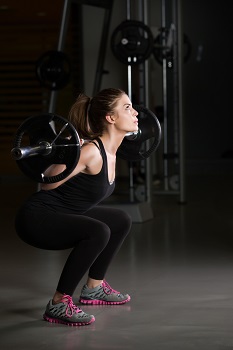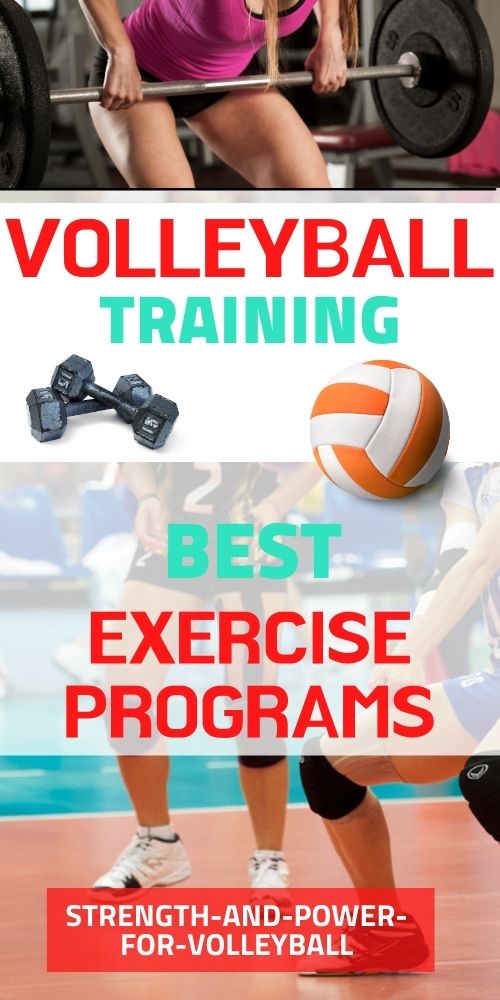- Home
- workout for volleyball
- volleyball workout
Volleyball Workout
Total Body Exercises for Volleyball
A volleyball workout often includes total body exercises such as deadlifts and power cleans.
Total body exercises are multi-joint exercises that work the entire body.
There are two types of total body exercises...
- Non-power exercises
- Power exercises
Total body non-power type exercises are often referred to as core or structural exercises.
Structural exercises emphasize training with weight loaded on the spine. When performing these exercises in a volleyball workout, it's important for the athlete to stabilize the body's core and maintain good posture.
Structural exercises that are performed quickly and explosively are called power exercises. Power exercises are executed at faster velocities and involve higher ground reaction forces.
Total Body Exercises for Your Volleyball Workout
-
Romanian Deadlift
You can gain strength by working more muscle by performing deadlifts than just about any other exercise. The deadlift may be the best total body exercise you could include in a volleyball workout.
Purpose:
Deadlifts build strength in your hamstrings, glutes, and back (the posterior chain strength commonly lacking in volleyball players).
Starting Position:
Stand in front of a barbell with your feet about shoulder width apart. Grab the barbell a little wider than hip width using a closed alternated grip.
Key points to proper starting position...
Back flat or slightly arched
Chest up and out
Scapula retracting
Feet flat with heels in contact with the floor
Eyes focused straight ahead
Action:
Lift the bar up off the ground by extending your hips and knees.
Key points to upward movement...
Keep the torso to floor angle constant and dont let the hips rise before the shoulders.
Keep the bar as close to your body (shins and thighs) as possible.
Maintain a flat back.
Key points to downward movement...
Slowly flex your hips and knees to lower the bar.
Maintain a flat back position.
Coaching cues:
Push to the ground through your heels.
Keep your chest up and out, shoulders brought together and back straight throughout the movement.
Keep your chest up to take pressure off your lower back.
Brace your core for a safer and more balanced movement.
Adjust the position of your hips for a different training effect. With the hips up high, you will have a better mechanical advantage and work your glutes and hamstrings more. With the hips low, the deadlift is more quad dominant. -
Dumbbell Front Squat to Press
This is a fun total body exercise to add to a volleyball workout.
Purpose:
Training coordination and strength by combining lower and upper body movement.
Starting Position:
Pick up a pair of dumbbells and stand with the dumbbells held at shoulder height with your palms facing one another.
Action:
Initiate the movement with your hips by move your butt back and down until the tops of your thighs are parallel to the floor. Explode up pushing to the ground through your heels. Use the upward momentum to raise the barbells up overhead. Finish the movement with straight arms and legs. Lower the dumbbells down to the starting position and repeat.
Coaching cues:
Keep your weight on your heels when squatting. Brace your core throughout the movement. -
One-arm, One-leg Dumbbell Row
Develop upper body functional strength by working across your body from shoulder to glute. A volleyball workout should include exercises like this that train the core in diagonal and rotational patterns to take full advantage of proper core function.
Purpose:
To develop upper back strength and power with stability at the hips.
Starting Position:
Stand on one leg with your hand on a stable surface (bench). Create a T with your body by lowering your upper body and raising your leg opposite your free hand. Pick up a dumbbell with your free hand and lower it.
Action:
Initiate the movement with your shoulder, not your arm. As you peform the row, keep your back, your shoulders, and the leg being raised in a straight line and parallel to the floor (a T shape).
Coaching cues:
Be sure to fire the glute muscles of the leg that is raised to help with hip extension. -
One-arm, One-leg Straight Leg Deadlift
The one-leg SLDL is a functional variation of the Romanian Deadlift exercise. A good reason to include this exercise in a volleyball workout is that stability is challenged while working the glutes and hamstrings. Another advantage of including this exercise in a volleyball workout is heavy loads arent necessary, so the potential for injury is a lot less.
Purpose:
This exercise stretches the hamstring of the supporting leg dynamically while working the hamstring of the opposite leg as a hip extensor.
Starting Position:
Hold the dumbbell in the hand opposite the supporting foot.
Action:
Lean forward at the waist lowering the dumbbell towards the ground while raising the free leg back and up, all while maintaining a straight line from heel to head. The dumbbell should be headed towards outside the opposite foot.
Coaching cues:
The free leg should stay inline with your back and shoulders. The knee of the supporting leg should stay slightly flexed.
If you enjoyed these tips and would like to keep it close to you at any time, just save this pin to your Pinterest Volleyball Training Board.
Power Exercises for Your Volleyball Workout
-
Push Press
A volleyball workout should contain exercises that train volleyball players to effectively put force into the ground and in turn receive useable ground reaction force. The push press trains ground reaction forces with a rapid hip and knee extension, accelerating the bar off your shoulders. You then finish the movement by using your arms to press the bar up overhead.
Purpose:
To train for explosive movement off the ground.
Starting Position:
You can either take a bar out of a squat rack or pick it up from the floor. Grab the bar with a closed pronated grip, slightly wider than shoulder width. Place the bar on the top of your anterior deltoids and clavicles (same position as the front squat). Place the feet shoulder width or slightly wider.
Action:
While keeping your back straight, flex your hips and knees. Forcefully extend your hips and knees, extending the elbows and raising the bar up overhead. Establish a balanced position with your arms straight. Slowly lower the bar to your shoulders by bending your elbows while flexing your hips and knees to help control the impact.
Coaching cues:
You can vary the thrust of the hip and knee extension during this exercise to alter the training effect. For example, using a more forceful hip and knee extension will result in the bar being thrown up higher. The higher the bar is thrown, the less the upper body will be needed to extend the bar up overhead. -
Power Clean
The power clean is probably the most common power exercise included in a volleyball workout. You are basically pulling a bar quickly and forcefully up from the floor to the front of the shoulders, all in one movement.
Purpose:
After learning good technique, the power clean can be a valuable exercise to include in a volleyball workout.
Starting Position:
Stand in front of a barbell with your feet between hip and shoulder width apart. Squat down so the hips are lower than the shoulders. Grab the barbell at slightly wider than shoulder width using a closed pronated grip. The hands should be outside the knees with the elbows fully extended. The feet should be flat on the floor with the bar about 1 inch in front of your shins.
Key points to proper starting position...
Back flat or slightly arched
Chest up and out
Scapula retracting
Feet flat with heels in contact with the floor
Eyes focused straight ahead
Action:
There are 4 phases to the upward portion of the exercise.
First pull...
Lift the bar up off the ground by forcefully extending your hips and knees.
Keep the torso to floor angle constant and dont let the hips rise before the shoulders.
Keep the elbows extended and the bar close to your shins.
Maintain a flat back.
Transition...
As the bar gets just above the knees, thrust the hips forward.
Re-flex the knees to get the bar above the knees against the thighs.
Keep the back flat or slightly arched with the elbows pointed out to the sides.
Second pull...
Forcefully extend the hips and knees while plantar flexing the ankles (lifting your heels up off the ground).
Keep the bar as close to the body as possible.
Keep the back flat and elbows pointing out.
Keep the shoulders over the bar and elbows extending as long as possible.
When your lower body reaches full extension, shrug your shoulders upward without flexing your elbows.
As the shoulders reach there highest point, pull your body under the bar by flexing your elbows.
Due to the explosive nature of this exercise, the feet may come up off the floor.
The catch...
Rotate the arms around and under the bar.
Flex the hips and knees into a quarter squat position.
Catch the bar with a straight tight torso with the feet flat on the floor.
Stand up by extending the hips and knees.
Key points to downward movement...
Flex your hips and knees and slowly lower the bar to your thighs.
Squat down and place the bar on the ground with the elbows fully extended.
Coaching cues:
The upward portion of the movement should be done continuous without interruption. Throughout the movement, the back should remain in a flat or slightly arched position while bracing your core.
It's important to include total body and power exercises in a volleyball workout because of the sport specific nature of the exercises. Including such exercises in your volleyball workout is ideal because of the great amount of functional strength you can develop.
Power exercises such as cleans are especially important because of how similiar the movement is to explosive jumping.
Total Body Exercise Volleyball Workout Related Pages
Sport Specific Conditioning for Volleyball
Dynamic Volleyball Flexibility
